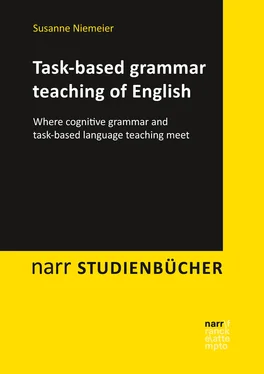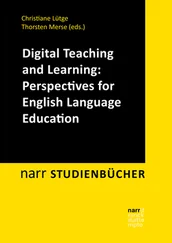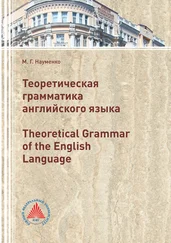Although oral production had finally entered the foreign language classroom and every learner had maximal speaking time, in the end the method did not really work and came in for severe criticism from the 1970s onwards. One of the reasons for its failure is certainly the fact that language learning is a far more complex endeavour than, for example, learning to ride a bike or learning to tie one’s shoe laces, which can both easily be learnt by stimulus-repetition-response action chains, another reason was the fact that the kind of language used did not frequently approximate normal communication, as no learner would ever encounter a native speaker who, for example, would utter an isolated sentence in the active voice in order for the learner to transform this sentence into the passive voice. Therefore, the learners were still not prepared for everyday communication, although they will have had a far better pronunciation than the learners having been taught according to the Grammar-Translation Method. For all these reasons, the audiolingual method was abandoned reasonably soon and many schools only used their expensive language laboratories for writing classroom tests, as the learners could sit at a distance from each other.
Other second language acquisition theories followed suit, but none of them lasted for long until the upstart of communicative language teaching began. According to NUNAN (2015: 10), “communicative language teaching was less a method than a broad philosophical approach to language, viewing it not so much as a system of rules but as a tool for communication”. One of its earliest appearances is to be found in KRASHEN’s ‘Monitor Model’1, consisting of five hypotheses which claim, for example, that acquisition and learning are two different processes. According to KRASHEN, acquisition is what happens in natural foreign language settings, for example, when a child and its parents move to a country where another language is spoken and the child starts to pick up the language from everyday interactions with native speakers of that language. This happens subconsciously and the aim is communication. Learning, on the other hand, happens consciously, usually in an instructed setting, and its aim is the mastery of the structural rules of a language. KRASHEN claimed that learning can never become acquisition2 and that acquisition is the better process.
Although KRASHEN’s model plays a fundamental role in the development of second language acquisition theories, it has been heavily criticised as being too rigid (and also untestable) in all its claims. Concerning the role of grammar, KRASHEN had claimed that it would develop on its own during communication and did not need to be taught explicitly. ACHARD (2008: 433) sums up the situation quite adequately by claiming that “the rise of the communicative models of instruction made instructors so suspicious of undue focus on structure that in the 1980s and early 1990s systematic grammatical instruction was banned from many language classrooms”.
Altogether, it can be stated that the importance of grammar started to lose more and more ground in the foreign language classroom. Thus, the pendulum swung from grammar’s all-importance in the Grammar-Translation Method via its lesser importance in the Audiolingual Approach to its lack of importance in most communicative approaches.
However, implicit instruction (i.e., grammar developing on its own during communication, such as KRASHEN had claimed) does not seem to work that well either, at least not for all grammatical phenomena3. This fact is well-known from studies on Canadian total immersion projects4 (see, for example, TARONE/SWAIN 1995 or SWAIN 2000), which have shown that grammar does not develop on its own just by exposing the learners to rich input but that the result is rather one of fossilised reduction.
What is more, various meta-analyses of SLA studies over the last fifteen years have come to the conclusion that “instruction that incorporates explicit (including deductive and inductive) techniques leads to more substantial effects than implicit learning” (NORRIS/ORTEGA 2000: 500) and that the effect sizes for an explicit instruction of both simple and complex language features were a lot more pronounced than those for an implicit instruction (cf. SPADA/TOMITA 2010). Along these lines, CAMERON (2001: 108) argues that “grammar may emerge naturally in first language (…) but the grammar of a foreign language is ‘foreign’, and grammar development requires skilled planning of tasks and lessons, and explicit teaching”.
Furthermore, proponents from other academic fields, in this case cognitive linguistics, such as N. ELLIS or MACWHINNEY, claim that “language acquisition can be speeded up by explicit instruction” (N. ELLIS 2002: 175) and that “from the viewpoint of psycholinguistic theory, providing learners with explicit instruction along with standard implicit exposure would seem to be a no-lose proposition” (MACWHINNEY 1997: 278). Although the arguments of the defenders of grammar are strong, they have not been completely assimilated by or at least been filtered down into second language teaching propositions and methods.
In the wake of the criticism raised against it, communicative language teaching has developed two versions, a weak one and a strong one. The strong view keeps up KRASHEN’s claim (1982) that communication is more or less enough to develop learners’ foreign language skills and that an explicit teaching of grammar is unnecessary, whereas the weak view maintains that an explicit teaching of grammar can be beneficial for learners. According to R. ELLIS (2003: 30), task-based language teaching is also a strong form of communicative language teaching, as “tasks provide the basis for an entire language curriculum”, a view which obviously disregards form completely, and in which it is not important “what the learners will learn, only how they will learn” (R. ELLIS 2003: 31). The distinction between a structured syllabus and the methodology used thus becomes blurred, as in such a view the syllabus mainly consists of the task-based methodology. It is quite difficult, though, to imagine this in practice, as this view would not allow language competences to be planned nor sequenced. In the current German context, with its structured curricula and its focus on competences to be acquired, it would be impossible to implement.
The weak view of communicative language learning is also known as ‘Focus-on-Form’ (see, for example, DOUGHTY/WILLIAMS 1998) and suggests to keep up the communicative foreign language classroom but to enhance it with grammar explanations and exercises when grammatical problems come up in classroom discussions. Supporters of ‘Focus-on-Form’ maintain that erroneous forms have to be corrected so that they do not fossilise or are imitated by other learners. ‘Focus-on-Form’ does not want to establish a renewal of a didactically oriented grammatical progression in the language that the learners are exposed to, but nevertheless argues that a focus on form, whenever necessary, should be integrated. Researchers, however, do not completely agree on the place for such an integration, as some see it in the form of “briefly drawing students’ attention to linguistic elements” (LONG 2000: 185) in a communicatively based context, whereas others relate to instruction that intentionally focuses on specific linguistic forms in the context of meaningful language use, be this proactively or reactively (cf. R. ELLIS 2003).
However, at least when referring to LONG’s view quoted above, such a focus on form normally has a rather remedial function as it only applies when learners do something wrong, i.e., it is not meant to be used for systematically introducing a new grammar topic and make the learners understand it but is instead meant to repair the learners’ language flaws when these become apparent. This can be seen as somewhat counterintuitive, as in such cases the learners have to acquire/learn a certain structure twice, once in the communicative phase, where they build their own hypotheses how to use a certain grammatical construction, and once in the repair phase, where they have to modify their own interlanguage hypotheses on the grammatical structure in question.
Читать дальше












